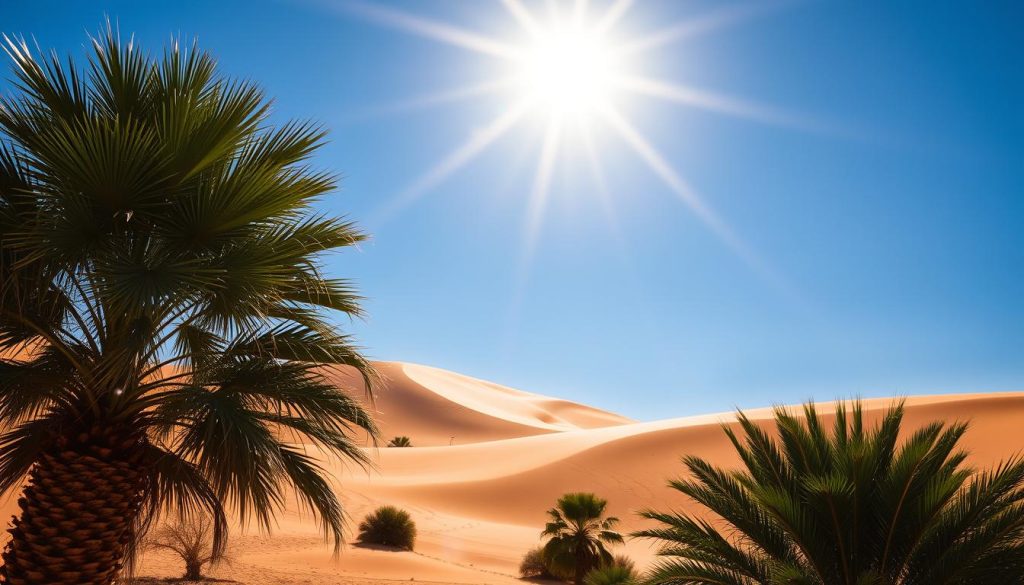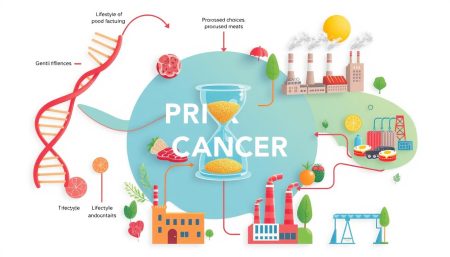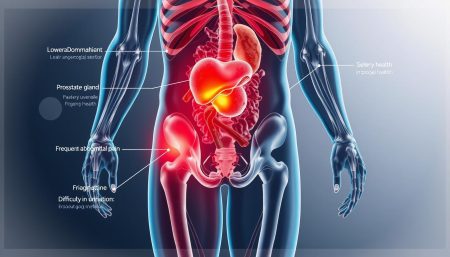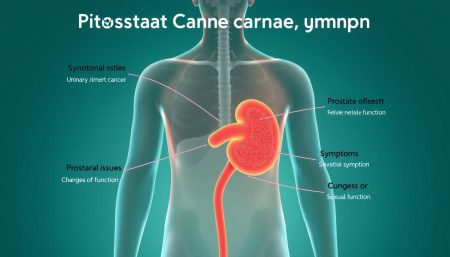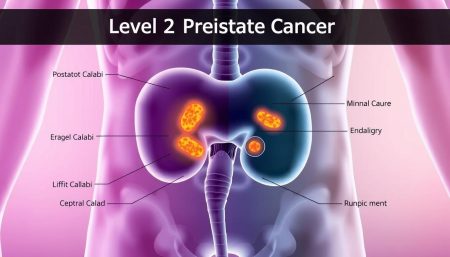The Tropic of Cancer is a special line on our planet. It is 23.5 degrees north of the equator. This line greatly affects Earth’s climate and seasons. At the Tropic of Cancer, the Sun shines directly overhead once a year. This happens on the June solstice, the longest day in the Northern Hemisphere. The Earth’s tilt makes this event possible.
This latitude defines our planet’s tropical zone. It influences weather patterns and shapes environments in many countries. From deserts to lush forests, the Tropic of Cancer impacts life along its path.
Understanding the Tropic of Cancer
The tropic of cancer is a key line on Earth. It helps define our planet’s climate zones and seasons. Let’s look at its location, history, and why it’s important in global geography.
Geographical Definition and Location
The tropic of cancer is the northernmost circle where the Sun is directly overhead at noon. It’s 23.5 degrees north of the equator. This line marks the start of the tropical zone in the Northern Hemisphere.
Historical Discovery and Naming
Ancient Greek astronomers found this line first. They called it the Tropic of Cancer because the Sun was in Cancer during summer solstice back then. Now, the Earth’s tilt has changed, so it’s not in Cancer anymore.
Significance in Global Geography
The tropic of cancer is key in shaping our world’s climate. It’s the northernmost point where the Sun’s rays hit directly overhead. This line divides the tropics from temperate regions, affecting weather, rainfall, and plants worldwide.
| Feature | Tropic of Cancer | Equator |
|---|---|---|
| Latitude | 23.5°N | 0° |
| Climate | Tropical/Subtropical | Tropical |
| Sun’s Position | Directly overhead once a year | Directly overhead twice a year |
The Mathematical Position: 23.5 Degrees North
The Tropic of Cancer is a special line on Earth, 23.5 degrees north of the equator. It’s not by chance. It’s because of Earth’s tilt. Our planet’s axis is tilted at 23.5 degrees as it orbits the sun.
This tilt is key to our seasons. When the Northern Hemisphere faces the sun, the Tropic of Cancer gets direct sunlight. This happens around June 21st, the summer solstice.
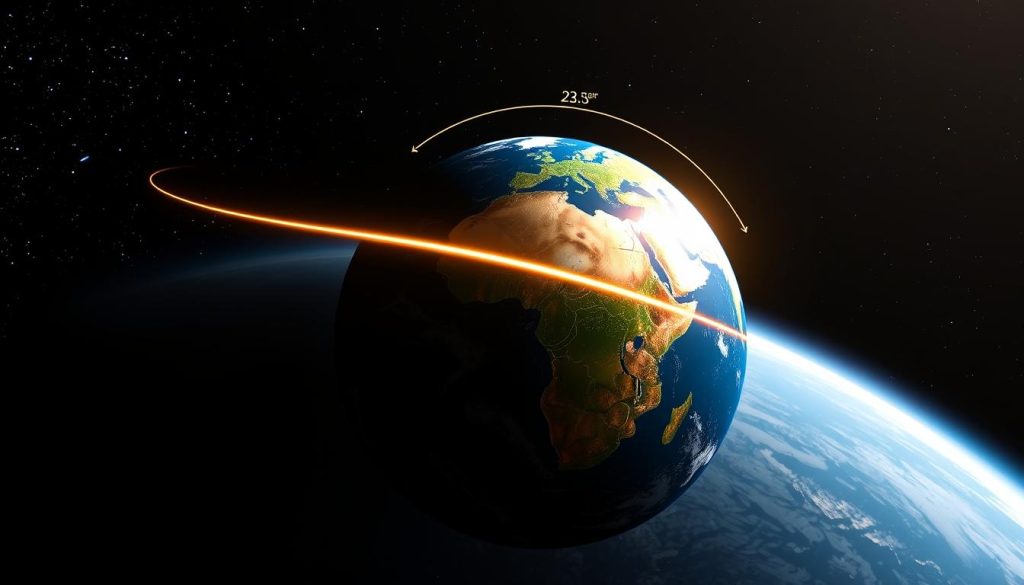
The Tropic of Cancer’s exact spot can change over time. These small shifts happen over thousands of years. They affect Earth’s axis tilt by tiny fractions of a degree.
| Aspect | Measurement |
|---|---|
| Latitude | 23.5° North |
| Earth’s Tilt | 23.5° |
| Distance from Equator | Approximately 1,621 miles |
Knowing the Tropic of Cancer’s math helps us understand climate patterns and seasonal changes. It shows how Earth’s shape impacts our environments and ecosystems.
How Earth’s Tilt Creates the Tropical Line
Earth’s tilt is key in shaping our climate zones and seasons. It creates the Tropic of Cancer, the northernmost point where the sun is directly overhead.
Axial Tilt Mechanics
The earth’s tilt of 23.5 degrees from its orbital plane is vital. This tilt stays the same as Earth orbits the sun. It makes the Northern Hemisphere lean towards the sun in some seasons and away in others.
Orbital Influence on Position
Earth’s elliptical orbit around the sun also affects the Tropic of Cancer’s position. The planet’s changing distance from the sun and its tilt determine where the sun’s rays hit most directly.
Solar Alignment Patterns
The summer solstice is a special day at the Tropic of Cancer. On June 20 or 21, the sun is directly overhead at noon. This marks the start of summer in the Northern Hemisphere and winter in the Southern Hemisphere.
| Season | Northern Hemisphere | Southern Hemisphere |
|---|---|---|
| Summer Solstice | June 20/21 | December 21/22 |
| Winter Solstice | December 21/22 | June 20/21 |
| Sun’s Position | Directly over Tropic of Cancer | Directly over Tropic of Capricorn |
Countries and Territories Along the Tropic of Cancer
The Tropic of Cancer runs through many lands, changing their geography and climate. It goes through 16 countries and 3 territories. Each place has its own special features because of its tropical location.
From west to east, the Tropic of Cancer goes through:
- Mexico: Baja California’s deserts
- Bahamas: Pristine beaches
- Western Sahara: Vast desert expanses
- Mauritania: Sahel region
- Mali: Niger River delta
- Algeria: Northern Sahara
- Niger: Aïr Mountains
- Libya: Libyan Desert
- Egypt: Nile Valley
- Saudi Arabia: Empty Quarter
- UAE: Rub’ al Khali desert
- Oman: Al Hajar Mountains
- India: Thar Desert and Gangetic Plains
- Bangladesh: Sundarbans mangroves
- Myanmar: Shan Plateau
- China: Yunnan-Guizhou Plateau
- Taiwan: Central mountain range
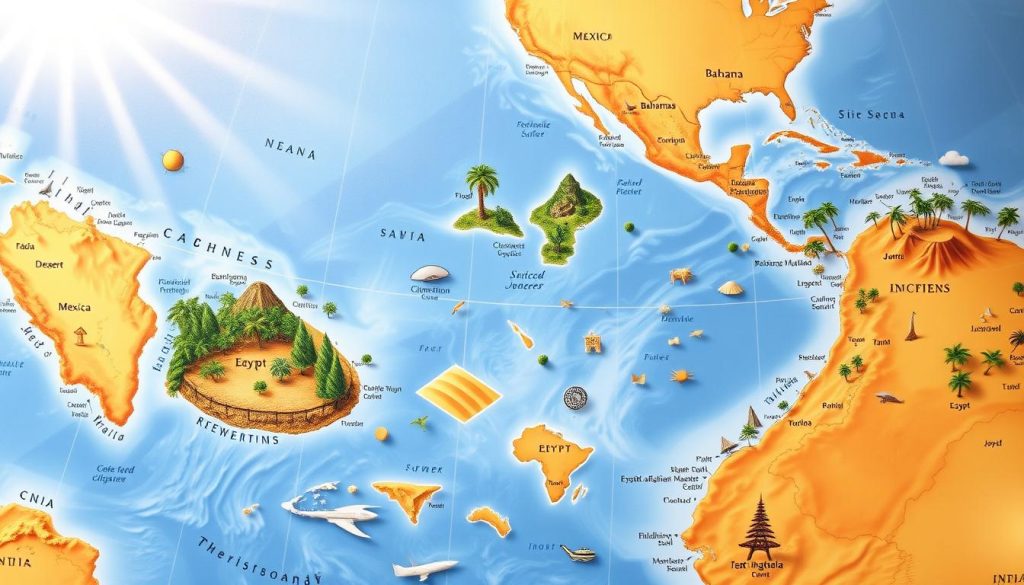
This line marks a big change in climate patterns. North of the tropic, seasons are more clear. But areas along and south have tropical climates.
The tropic’s position also affects rainfall. This creates lush forests in some places and big deserts in others.
| Region | Climate Type | Characteristic Landscape |
|---|---|---|
| Western Americas | Arid | Deserts, Coastal Plains |
| North Africa | Hot Desert | Sand Dunes, Rocky Plateaus |
| Middle East | Hot Desert | Sandy Deserts, Mountain Ranges |
| South Asia | Tropical Monsoon | River Deltas, Grasslands |
| East Asia | Subtropical | Mountains, Coastal Plains |
Seasonal Changes and Solar Movements
The Tropic of Cancer is key to Earth’s seasons and the Sun’s path. It’s the line where the Sun is directly overhead in the north. This affects how long days are and how bright the Sun is all year.
Summer Solstice Phenomena
The summer solstice happens when the Sun is highest in the sky at the Tropic of Cancer. It’s around June 21st, the longest day for the Northern Hemisphere. Places on the Tropic of Cancer get the Sun right overhead at noon then.
Direct Sunlight Patterns
The Sun’s angle changes with the seasons. In summer, the Tropic of Cancer gets more direct sunlight, making it warmer. Winter brings less sunlight and cooler weather. This solar movement shapes the climate in these areas.
Day Length Variations
Day length changes a lot near the Tropic of Cancer. Here’s a table showing these changes at different times:
| Season | Daylight Hours | Night Hours |
|---|---|---|
| Summer Solstice | 13.5 | 10.5 |
| Winter Solstice | 10.5 | 13.5 |
| Spring/Fall Equinox | 12 | 12 |
These changes in the Tropic of Cancer affect weather, ecosystems, and human life in the area.
Climate Characteristics of the Northern Tropics
The tropics near the Tropic of Cancer have special climate features. This area includes everything from lush rainforests to dry deserts. The temperatures stay pretty much the same all year, with little change.

How much rain falls in the northern tropics varies a lot. Some places get a lot of rain, while others stay dry for a long time. The monsoon season is key, bringing rain to many areas along the Tropic of Cancer.
Common weather events in the northern tropics include:
- Tropical storms and hurricanes
- Intense heat waves
- Sudden downpours
- Extended dry periods
The northern tropics are known for their warmth and humidity. Unlike temperate areas, which have four seasons, tropical places have only two: wet and dry. This climate supports amazing biodiversity, making the tropics some of the most vibrant places on Earth.
Impact on Global Weather Patterns
The Tropic of Cancer is key in shaping global weather. It’s the northernmost point where the sun hits directly overhead. This line affects climate zones and air movements around the world.
Atmospheric Circulation
The Tropic of Cancer drives the Hadley Cell, a big air movement pattern. This cell shapes weather in tropical and subtropical areas. It impacts how rain and temperature spread globally.
Precipitation Distribution
Rainfall patterns are linked to the Tropic of Cancer’s location. Places near it tend to be dry because of sinking air. But areas just south get more rain. This creates different ecosystems, from rainforests to deserts.
Wind System Effects
The Tropic of Cancer also shapes major wind systems, like trade winds and monsoons. These winds move ocean currents and influence global rainfall patterns. Knowing these systems helps predict weather and plan for climate change.
| Climate Zone | Precipitation | Wind Pattern |
|---|---|---|
| Tropical | High | Trade Winds |
| Subtropical | Low | Horse Latitudes |
| Temperate | Moderate | Westerlies |
Scientists can predict climate changes by studying the Tropic of Cancer’s weather impact. This helps communities get ready for environmental challenges ahead.
Agricultural Zones and Vegetation Types
The Tropic of Cancer divides different climate zones, creating unique farming areas. It affects how people farm and the plants that grow there. From dry deserts to green rainforests, it shows how nature can adapt.
In the tropics near the Tropic of Cancer, farmers grow many crops for warm weather. In Asia, rice paddies are common. In Central America, coffee grows well. Mangoes and sugar cane are also found here. The sun and rain allow for farming all year.
Nature’s plants vary a lot along this line. Rainforests with tall trees and many plants are found in some places. But, dry areas have only a few plants, like cacti. Savannas have grasses and trees that handle seasonal rains.
| Climate Zone | Common Crops | Native Vegetation |
|---|---|---|
| Tropical Rainforest | Bananas, Cocoa, Rubber | Mahogany, Orchids, Ferns |
| Tropical Savanna | Sorghum, Millet, Cotton | Acacia Trees, Baobab, Grasses |
| Tropical Desert | Date Palms, Olives | Cacti, Yucca, Desert Sage |
The areas near the Tropic of Cancer are key for food worldwide. They give us tropical fruits, spices, and more. Learning about these places helps us farm better and save special plants.
Cultural Significance Across Different Civilizations
The Tropic of Cancer is deeply meaningful to many cultures. It’s a line in the sky that has influenced our traditions for ages.
Ancient Navigation Methods
Old sailors used the Tropic of Cancer to find their way. They looked at the stars and the sun’s spot in the sky. At the summer solstice, when the sun is highest here, they could tell exactly where they were.
Cultural Celebrations
Many cultures celebrate the summer solstice, when the sun hits the Tropic of Cancer. In ancient Egypt, it was the start of the New Year and the Nile’s flood. Today, places like Stonehenge in England and Chichen Itza in Mexico attract many to see the sun’s alignment with old buildings.
Traditional Beliefs
The Tropic of Cancer is part of many old beliefs. Some see it as a line between the real and spiritual worlds. In Chinese astrology, it’s linked to the summer solstice and the longest day. Native American tribes held sun ceremonies when it was at its highest.
These traditions show how the Tropic of Cancer has shaped our history and geography. They reveal its role in our understanding of the world and our place in it.
Relationship with Other Major Latitude Lines
The Tropic of Cancer is key in Earth’s geography. It works with other important latitude lines. Together, they shape our planet’s climate zones.
The equator, at 0° latitude, splits Earth into two hemispheres. It gets the most sunlight all year. The Tropic of Cancer, at 23.5°N, is where the sun hits directly in June.
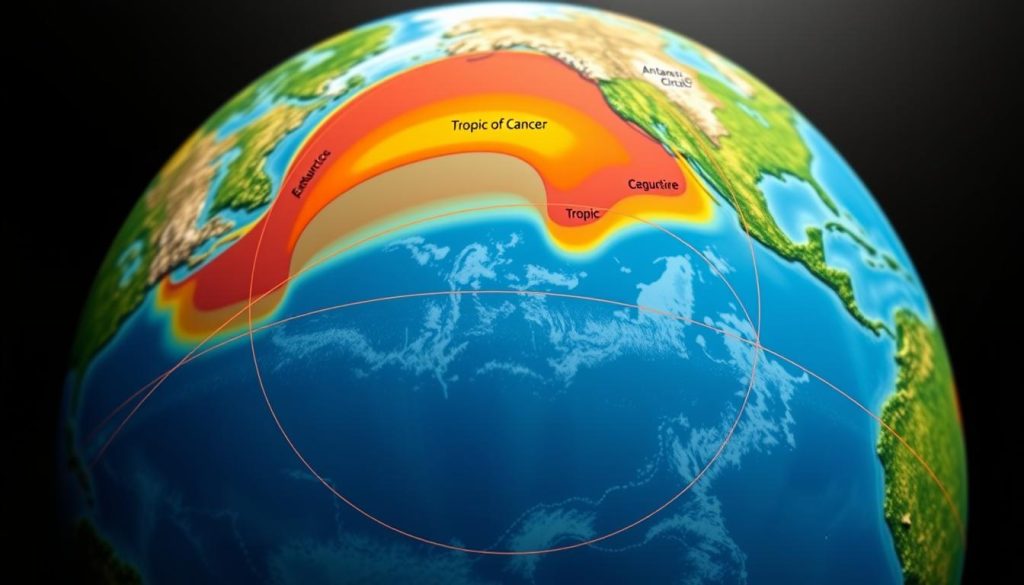
- Tropical Zone: Between the Tropic of Cancer and Tropic of Capricorn
- Temperate Zones: Between the tropics and polar circles
- Polar Zones: Beyond the Arctic and Antarctic Circles
These latitudes affect global weather, ocean currents, and air movement. Knowing how they work helps us understand different climates and seasons.
| Latitude Line | Position | Significance |
|---|---|---|
| Equator | 0° | Divides Earth into hemispheres |
| Tropic of Cancer | 23.5°N | Northern boundary of tropics |
| Tropic of Capricorn | 23.5°S | Southern boundary of tropics |
| Arctic Circle | 66.5°N | Marks polar day and night |
| Antarctic Circle | 66.5°S | Marks polar day and night |
Environmental Challenges in Tropic of Cancer Regions
The Tropic of Cancer is a key line in geography facing big environmental challenges. These problems come from nature and human actions. They change the landscape and harm ecosystems.
Desertification Issues
Desertification is a big threat in many Tropic of Cancer areas. It turns good land into desert, hurting farming and wildlife. In China’s Gobi Desert, sand is moving into farmland, pushing people to move or change their ways.
Climate Change Effects
Climate change makes things worse in these areas. Warmer temperatures mess up rain patterns, causing more droughts and floods. The Caribbean islands, near the Tropic of Cancer, see stronger hurricanes and rising seas. This puts coastal areas and wildlife at risk.
Conservation Efforts
There are efforts to fight these problems. The Great Green Wall project in Africa wants to plant a wall of trees across the continent, near the Tropic of Cancer. It aims to stop desert growth and help local people financially.
| Region | Environmental Challenge | Conservation Effort |
|---|---|---|
| Sahel, Africa | Desertification | Great Green Wall project |
| Caribbean Islands | Sea level rise | Coral reef restoration |
| Gobi Desert, China | Expanding desert | Reforestation programs |
These challenges show how climate, geography, and human actions mix in the Tropic of Cancer. As our world changes, it’s key to understand and tackle these issues for the future of these areas.
Economic Activities Along the Tropical Belt
The Tropic of Cancer passes through many different areas, creating unique economic scenes. This line in the world’s geography affects many industries in the tropics. Countries along it use their natural resources and climate to grow their economies.

Agriculture does well in these warm places. Tropical fruits, coffee, and spices are big exports. Rice paddies cover large areas, feeding millions. Palm oil production is a big economic factor in Southeast Asia.
Tourism is booming in many tropical spots. People come for the beaches and forests. Resorts in Mexico, the Caribbean, and Asia make a lot of money from visitors. Ecotourism is also growing, with people exploring unique tropical areas.
Extracting natural resources is key in some economies. Oil fields in the Middle East and mineral deposits in Africa are big players in global markets. These industries create jobs but also raise environmental worries.
| Economic Sector | Key Products/Services | Major Regions |
|---|---|---|
| Agriculture | Tropical fruits, coffee, rice | Southeast Asia, Central America |
| Tourism | Beach resorts, ecotourism | Caribbean, Southeast Asia |
| Natural Resources | Oil, minerals | Middle East, Africa |
The tropical climate brings both challenges and chances for economic growth. Monsoons affect farming. But the warm weather lets crops grow all year in many places.
As trade changes, countries in the tropics are adjusting. Some are moving into new areas. Others are using their location to connect the world.
Modern Navigation and the Tropic of Cancer
The Tropic of Cancer is key in modern navigation. It affects how we travel around the world. It shapes GPS technology, maritime routes, and aviation paths.
GPS Technology Integration
GPS systems use the Tropic of Cancer for precise locations. It’s a reference point for finding places and calculating distances. Navigation apps and devices use it to give accurate directions and plan routes.
Maritime Navigation
Sailors have used the Tropic of Cancer for centuries. Today, it’s used by modern ships too. It helps captains plan routes that save fuel and avoid bad weather.
| Aspect | Impact on Maritime Navigation |
|---|---|
| Route Planning | Helps determine optimal shipping lanes |
| Weather Forecasting | Aids in predicting tropical storm patterns |
| Fuel Efficiency | Guides ships to utilize favorable currents |
Aviation Considerations
In aviation, the Tropic of Cancer affects flight paths and fuel. Pilots use it to plan routes for better winds. It helps airlines plan safer flights and save fuel.
The Tropic of Cancer’s role in geography goes beyond its physical mark. It’s vital in our global navigation systems. It’s key in our world of travel and commerce.
Future Shifts and Climate Change Impact
The Tropic of Cancer, Earth’s northern boundary line, might not stay put forever. Scientists are keeping a close eye on how climate change could affect its position. As our planet warms, it’s possible that Earth’s tilt might shift slightly. This could cause the Tropic of Cancer to move, changing which areas get the most direct sunlight.
Climate change is already impacting regions along this latitude line. Rising temperatures are making some areas drier, while others are seeing more extreme weather. These changes can affect human health and ecosystems. For example, some tropical forests might struggle to survive if it gets too hot and dry.
Looking ahead, even small shifts in the Tropic of Cancer could have big effects. If it moves north, new areas might become tropical. This could change where certain crops can grow and alter animal habitats. It might also affect weather patterns globally, not just near the tropical line. As we face these changes, it’s clear that understanding Earth’s tilt and its impact on climate is more important than ever.
FAQ
Q: What is the Tropic of Cancer?
A: The Tropic of Cancer is an imaginary line around Earth at about 23.5 degrees north of the equator. It’s the northernmost point where the Sun is directly overhead at the June solstice. This line defines Earth’s tropical zone in the Northern Hemisphere.
Q: Why is it called the Tropic of Cancer?
A: It’s called the Tropic of Cancer because in ancient times, the Sun was in the constellation Cancer during summer. Even though this isn’t true today due to Earth’s tilt changing, the name has stuck.
Q: How does the Tropic of Cancer affect climate?
A: The Tropic of Cancer shapes climate zones. Places near it have subtropical climates with hot summers and mild winters. It also affects global weather and where rain falls.
Q: Which countries does the Tropic of Cancer pass through?
A: It goes through countries like Mexico, the Bahamas, Egypt, and India. Each country has its own climate and geography because of its location near this line.
Q: How does Earth’s tilt create the Tropic of Cancer?
A: Earth’s tilt of about 23.5 degrees creates the Tropic of Cancer. This tilt means the Sun’s rays hit different places on Earth throughout the year. The Tropic of Cancer is the northernmost point during the June solstice.
Q: What happens at the Tropic of Cancer during the summer solstice?
A: At the summer solstice, the Sun is directly overhead at noon along the Tropic of Cancer. This is the longest day in the Northern Hemisphere and the start of summer.
Q: How does the Tropic of Cancer affect agriculture?
A: It affects where and what crops can grow. Places near it are good for growing tropical and subtropical crops like citrus fruits and cotton. But, some areas face challenges like desertification.
Q: What is the relationship between the Tropic of Cancer and navigation?
A: The Tropic of Cancer was key for navigation in the past. It helped sailors find their way. Today, it’s used in GPS and for planning flights and shipping routes.
Q: How might climate change affect the Tropic of Cancer?
A: Climate change could change the weather and crops near the Tropic of Cancer. It might also change ecosystems and weather patterns. Over time, Earth’s tilt could move the tropic slightly.
Q: What cultural significance does the Tropic of Cancer have?
A: It’s important in many cultures, tied to solstice celebrations and old beliefs. Ancient people used it for navigation and keeping time. Today, it’s studied in astronomy and geography around the world.












